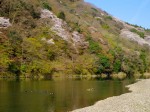- Home
- To-ji Temple Highlights (Kon-do,Gojyu-no-to)
To-ji Temple Highlights (Kon-do,Gojyu-no-to)
To-ji Temple Highlights
The information about To-ji Temple Highlights is presented here. To-ji Temple has many highlights, including Kon-do, Gojyu-no-to (Five-story Pagoda), and Ko-do, but Kon-do and Gojyu-no-to are the two that must be seen. Ko-do was built earliest when To-ji Temple was founded, and its history is fascinating. Gojyu-no-to is beautiful during the day, but it is also beautiful at night when it is illuminated. If you have a chance, visit the interior of the first floor of Gojyu-no-to and the three-dimensional mandala inside Ko-do.
★To-ji Temple (location,history)
【Kon-do (Main Hall, Hondo, 金堂)】
Kon-do (National Treasure) was rebuilt in 1603 with the donation from Toyotomi Hideyori, the son of Toyotomi Hideyoshi. Kon-do is said to have been rebuilt by copying Daibutsu-den (Great Buddha Hall) of Hoko-ji Temple, which was built by Toyotomi Hideyoshi, and is considered one of the seven wonders of To-ji Temple as “Daibutsu-den utsushino Kon-do (Kon-do Copying Daibutsu-den). Kon-do houses the statue of Yakushi Nyorai and two supporting statues of Nikko Bosatsu and Gakko Bosatsu. Kon-do is the largest building in To-ji Temple, with a roof called a mokoshi, which at first glance appears to be a two-story structure.
【Gojyu-no-to (Five-story Pagoda, 五重塔)】
Gojyu-no-to (National Treasure) was rebuilt in 1644 with the donation of Tokugawa Iemitsu, the 3rd shogun of the Edo shogunate. Gojyu-no-to is about 54.8 meters high and is the tallest wooden pagoda in Japan. Gojyu-no-to has become a symbol and landmark of To-ji Temple. Gojyu-no-to is centered on the central pillar representing Dainichi Nyorai, and houses the statues of Kongokai-Shibutsu and Hachidai-Bosatsu. Gojyu-no-to has an esoteric space inside the 1st floor, which is decorated with beautiful colors, the Mandala of Kongokai on the 4 pillars, Hachidai-Ryuo on the 4 side pillars, and the statues of Shingon Hasso (Shingon Eight Ancestors) on the walls.
【Daishi-do (Mie-do, Fudo-do, 大師堂, 御影堂, 不動堂)】
Daishi-do (National Treasure) consists of Zen-do (the front hall), Kou-do (the back hall), and the Cyu-mon gate. Kou-do was rebuilt in 1380, and Zen-do and Cyu-mon gate were added in 1390. Zen-do houses the statue of Kobo-daishi Kukai, and Kou-do houses the statue of Fudo Myoo (secret Buddha), who was enshrined by Kobo-daishi Kukai. Daishi-do is the center worship for Kobo Daishi, and since the early Kamakura period (1185-1333), the Shojin-Ku where meals are offered to Kobo-daishi Kukai, has been held at 6:00 every day.
【Ko-do (Lecture Hall, 講堂)】
Ko-do (Important Cultural Property) was rebuilt in 1491. Ko-do is the central temple of Esoteric Buddhism, which Kobo-daishi Kukai was the first to start building. Ko-do is decorated with the three-dimensional mandala designed by Kobo-daishi Kukai, which expresses the world view of Shingon Esoteric Buddhism. Ko-do houses the 21 Buddhist statues centered on Dainichi Nyorai, the head of Shingon Esoteric Buddhism, including the statues of Gochi-Nyorai, Godai-Bosatsu, Godai-Myoo, Shi-tenno, Bonten, and Taisakuten.
【Ho-zo (宝蔵)】
Ho-zo (Important Cultural Property) is said to have been built in the late Heian period (1086-1184). THo-zo is said to be the oldest building on the temple grounds. Ho-zo houses the temple treasures that were given to Kobo-daishi Kukai by his master Keika, and brought back from China.
【Kanjo-in (灌頂院)】
Kanjo-in (Important Cultural Property) was damaged by the Fushimi earthquake in 1585 and and rebuilt in 1629 by Tokugawa Iemitsu, the 3rd shogun of the Edo Shogunate. Kanjo-in does not house the statues of Buddha, but is used for ceremonies such as Denbo Kanjo, which teaches disciples the secrets of esoteric Buddhism.
【Renge-mon (Renge-mon Gate, Lotus Gate, 蓮花門)】
Renge-mon (National Treasure) was rebuilt in 1191 by Mongaku (Endo Tomori). Renge-mon is the oldest gate in the temple and is said to be the second oldest building in the temple after Ho-zo. According to legend, when Kobo-daishi Kukai went to Koyasan in Wakayama Prefecture, Fudo Myoo of Daishi-do saw him off at Renge-mon. It is said that beautiful lotus flowers bloomed under Fudo Myoo’s feet and on the path he walked, giving Renge-mon its name.
【Keiga-mon (Keiga-mon Gate, 慶賀門)】
Keiga-mon (Important Cultural Property) was built in the early Kamakura period (1185-1274). Keiga-mon faces Omiya-dori Street on the east side and is the main entrance to the temple. It is said that Keiga-mon was once used by imperial envoys.
【Nan-daimon (Nan-daimon Gate, 南大門)】
Nan-daimon (Important Cultural Property) was built in 1601 as Sai-daimon of Sanjusangen-do, and was moved from Sanjusangen-do to To-ji Temple in 1895. Nan-daimon is about 13 meters high and 18 meters wide, and is the largest gate in the temple. It is also the main gate of To-ji Temple.
【Other Highlights】
★Hyotan-ike Pond (瓢箪池) is located on the north side of Gojyu-no-to (Five-story Pagoda). Lotuses are distributed in Hyotan-ike Pond, and they are in full bloom from early summer every year.
★Jiki-do (Dining hall, 食堂) was destroyed by fire in 1930 and rebuilt in 1934. Jiki-do houses the statue of the eleven-faced Kannon , created by sculptor Myochin Tsuneo.
★Shoshi-bo (小子房) was rebuilt in 1934, on the 1,000th anniversary of the death of KoboDaishi Kukai. The former Shoshi-bo became the palace of Emperor Kogon during the Nanbokucho period (1337-1392).
【Remarks】
National treasures, important cultural properties, and other cultural assets may be closed to the public.
東寺見どころ (To-ji Temple Highlights)



